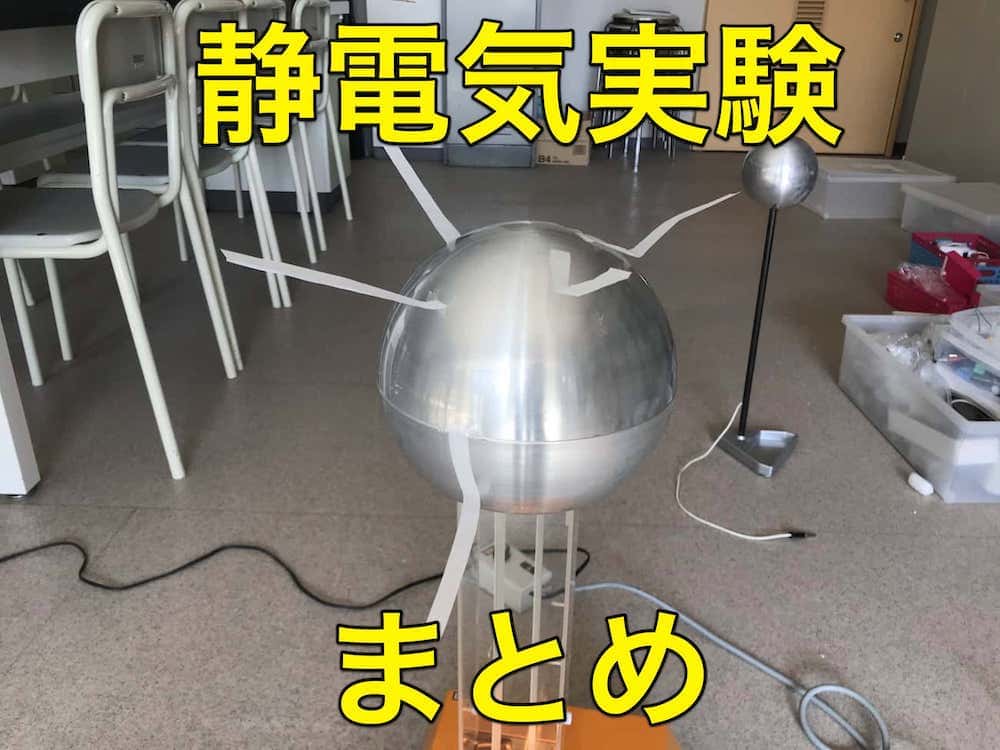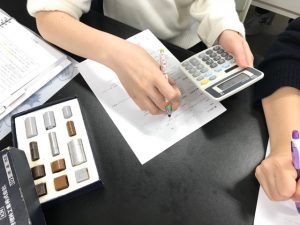The “Hyakunin Odoshi”: How a Hundred-Person Static Shock Became the Ultimate Science Show of Japan’s Edo Period
I’m Kuwako Ken, your Science Trainer. Every day is an experiment.
Crack! Have you ever touched a doorknob in winter and involuntarily cried out? Static electricity is all around us, but what would happen if dozens of people held hands and experienced this small crack all at once?
This was, in fact, a spectacular science entertainment show that became wildly popular in the Edo period, more than 200 years ago. Its name: “Hyakunin Odoshi” (The Hundred-Man Shock). This time, we’ll explore the history of this unique experiment created by geniuses and even show you how to recreate it!
What is “Hyakunin Odoshi”? The Science Show of the Edo Period!
The name “Hyakunin Odoshi” might sound a bit intimidating, but what exactly is it? First, please watch this video. This is the Hyakunin Odoshi. Perhaps some of you have experienced it in a school science class.
The “Hyakunin Odoshi” is an experiment where a large group of people hold hands to form a big circle and experience a jolt of static electricity all at once. Its history is old, dating back to the Elekiter, a static electricity generator invented by the genius inventor of the Edo period, Hiraga Gennai. After Gennai introduced the mysteries of electricity to Japan, the Dutch scholar Hashimoto Sokichi used this Elekiter to showcase the “Hyakunin Odoshi” as a public spectacle, which quickly became immensely popular.
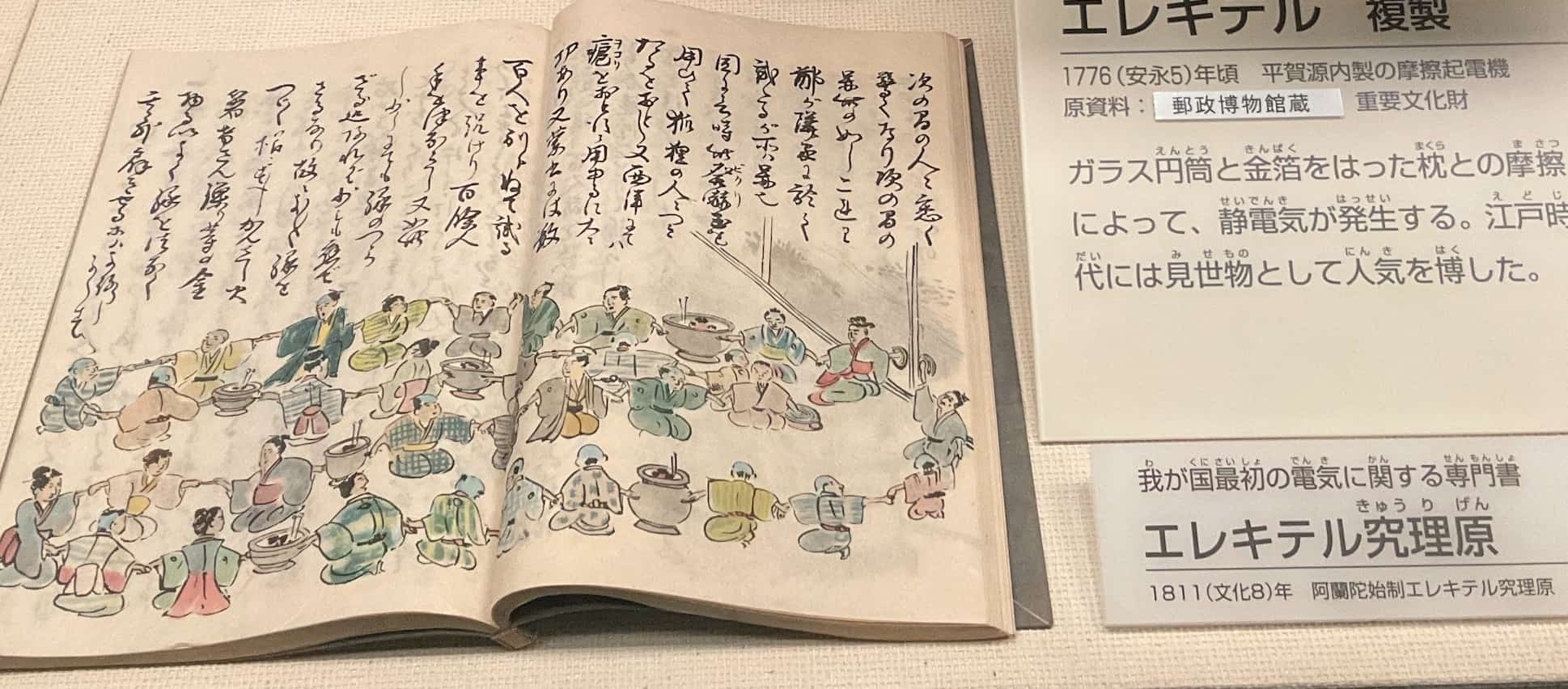
Although the name includes “Hundred People” (Hyakunin), it’s used to mean “many people,” and it can be successfully demonstrated with a class of about 40 students. I’ve also conducted this experiment before on a TV show with Suzu Hirose and the comedy duo Chocolate Planet, and they all gave fantastic reactions! Click here for more details.

Matsuo-san leaping up in surprise!
Why Were the People of Edo Period So Enthusiastic About Static Electricity?
Why did the “Hyakunin Odoshi” capture the hearts of the people of Edo so completely? The answer is hidden in what they wore on their feet.
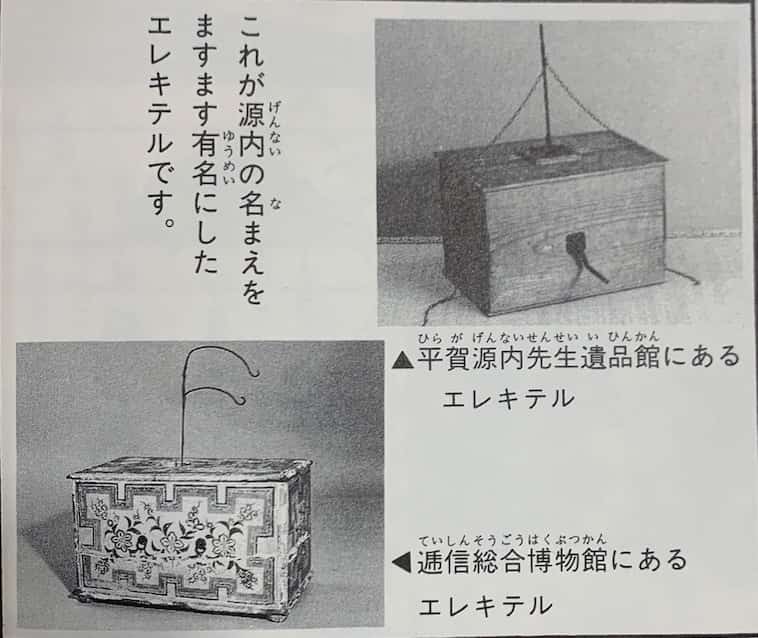
Quoted from Nihon no Denki: Hiraga Gennai (Shueisha)
It is said that there are almost no descriptions of static electricity in daily life in the historical texts of the Edo period (1). If you think about it, the people of that time wore straw sandals (waraji) or wooden clogs (geta). These materials conduct electricity easily, so any static charge generated on the body would immediately escape into the ground. In other words, they simply did not have the experience of that “crack!” at the doorknob.
In contrast, we in the modern era wear shoes with rubber soles. Rubber is an “insulator” that doesn’t conduct electricity, so charge gradually builds up in our bodies. That’s why we experience static electricity so often.
Against this backdrop, the static electricity created by the Elekiter and the “jolt!” experienced simultaneously by everyone holding hands in the Hyakunin Odoshi was an encounter with the unknown and the ultimate extraordinary entertainment for the people of Edo. This mysterious phenomenon was sometimes even referred to as “sorcery.”
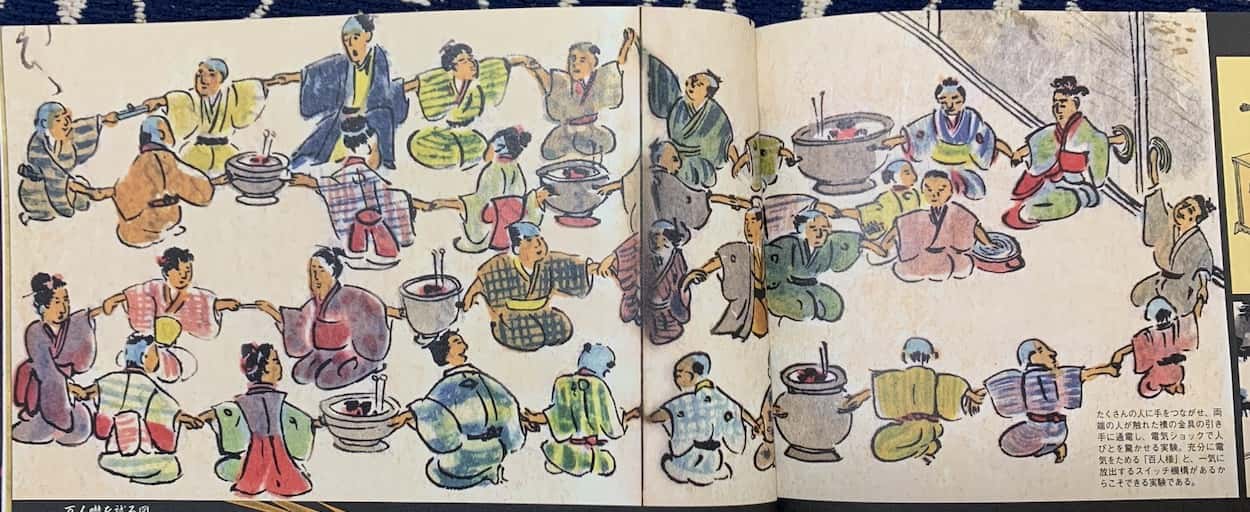
Diagram quoted from Oranda Shisei Elekiter Kyūrigen by Hashimoto Sokichi, Otona no Kagaku Magazine vol22 (Gakken) P24, 25
The Heart of Hyakunin Odoshi! Let’s Make a “Leyden Jar”!
What is a Leyden Jar?
Essential for this experiment is the device for storing static electricity, the Leyden Jar. Invented at Leiden University in the Netherlands in 1746, it is considered the world’s first electrical storage device (capacitor). Its mechanism is a simple structure: a non-conductive “insulator” (a plastic cup) sandwiched between two electrically conductive “conductors” (aluminum foil). You can easily make one with common materials, so let’s give it a try!
What You Need
Two plastic cups, aluminum foil, cellophane tape.
How to Make It
1. Cut the Aluminum Foil to the Shape of the Cup
Roll a cup over the aluminum foil to leave a trace, and cut it out with scissors. This foil will be taped to the outside and inside of the cup.
2. Wrap Aluminum Foil Around the Outside of the Cup
Tightly wrap the cut aluminum foil around the outside of one plastic cup.
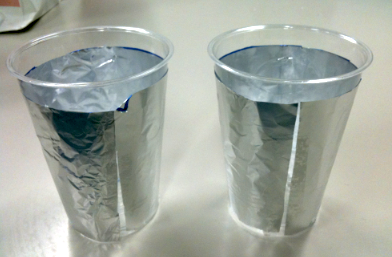
3. Attach a “Tongue” to the Inner Cup
For the second cup, attach aluminum foil to the inside. Then, create a “tongue”-like part that connects to the outside using a thin, long strip of aluminum foil.
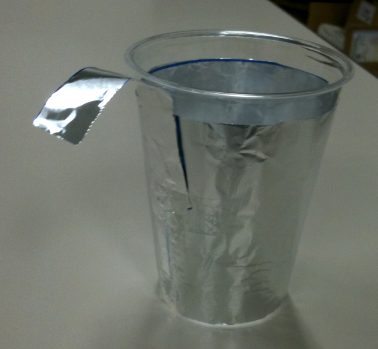
4. Stack the Two Cups
Place the cup from step “3” (with the tongue) inside the cup from step “2”. And there you have it—your homemade Leyden Jar is complete!

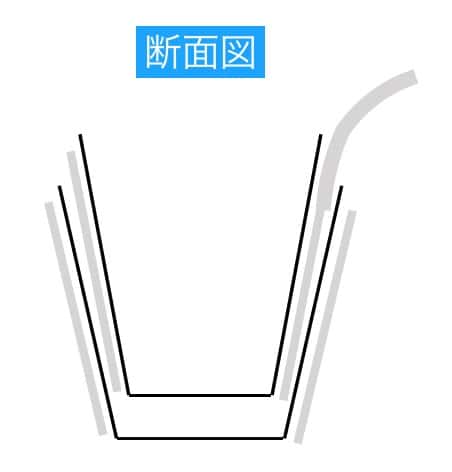
[Pro Tip]
Static electricity is very sensitive to humidity. Success is easier with small cups in the dry winter air, but if the humidity is high, such as during the rainy season, use a larger cup (500mL or more) with a larger surface area to increase your success rate!
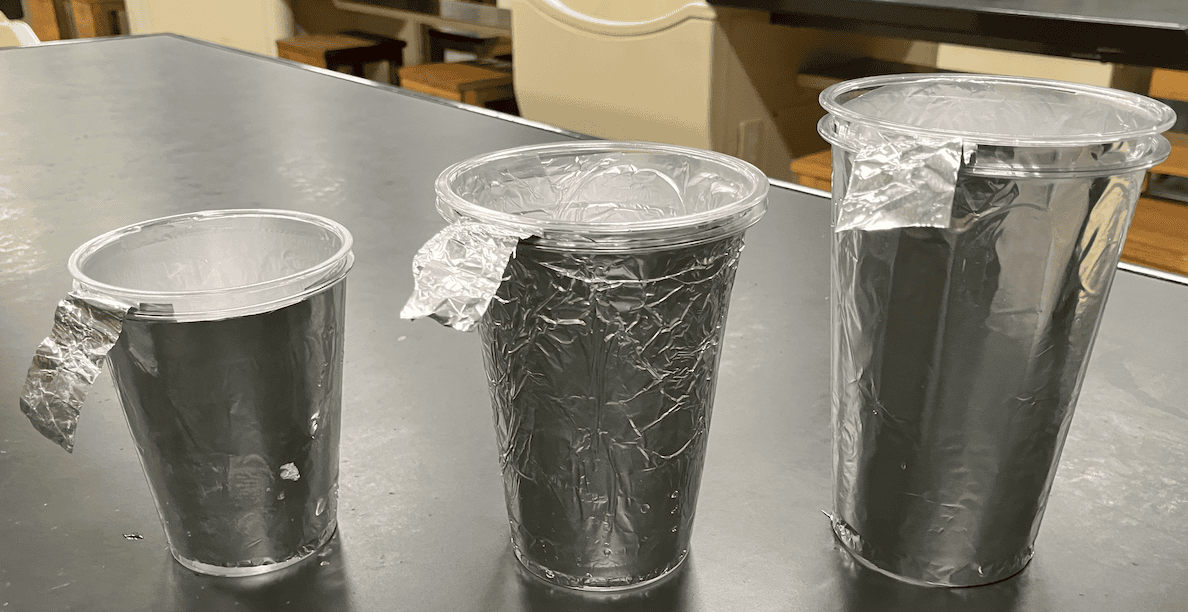
Of course, you can also use a commercially available Leyden Jar.

Time to Act! How to Do the Hyakunin Odoshi and the Science Behind It
1. Store the Static Charge
Generate static electricity by rubbing a plastic sheet (such as a clear file) with a cloth, and rub it repeatedly against the “tongue” part of the Leyden Jar to store the electricity. When you rub the negatively charged sheet, negative charge (electrons) accumulates on the inner aluminum foil. If you have a static electricity generator (Van de Graaff generator), you can charge it in an instant!

At this time, since the inner and outer aluminum foils are not touching directly, the electricity continues to accumulate.
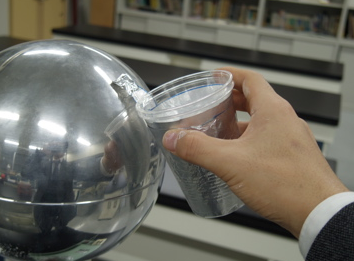
Charging using a Van de Graaff generator
2. Form a Circle and Hold Hands
Once ready, form a large circle by holding hands with your friends. One person at the end of the circle holds the outer aluminum foil of the cup, and the person at the other end gently touches the aluminum foil “tongue.”

3. 3, 2, 1… Discharge!
The moment the tongue is touched, the circuit is completed! The negative charge (electrons) stored in the inner cup flows instantly through the bodies of everyone in the circle and into the outer cup. This current causes the muscles to contract, and everyone feels the “jolt!” simultaneously.

3, 2, 1…

SCREAM!
This is the experiment that always gets the most excitement in the classroom every year. It’s a fantastic opportunity to safely and enjoyably experience the feeling of “electricity flowing through the body,” something we don’t normally notice. Definitely try this with a large group of friends!
Here is a video of when we failed. Well, it happens…
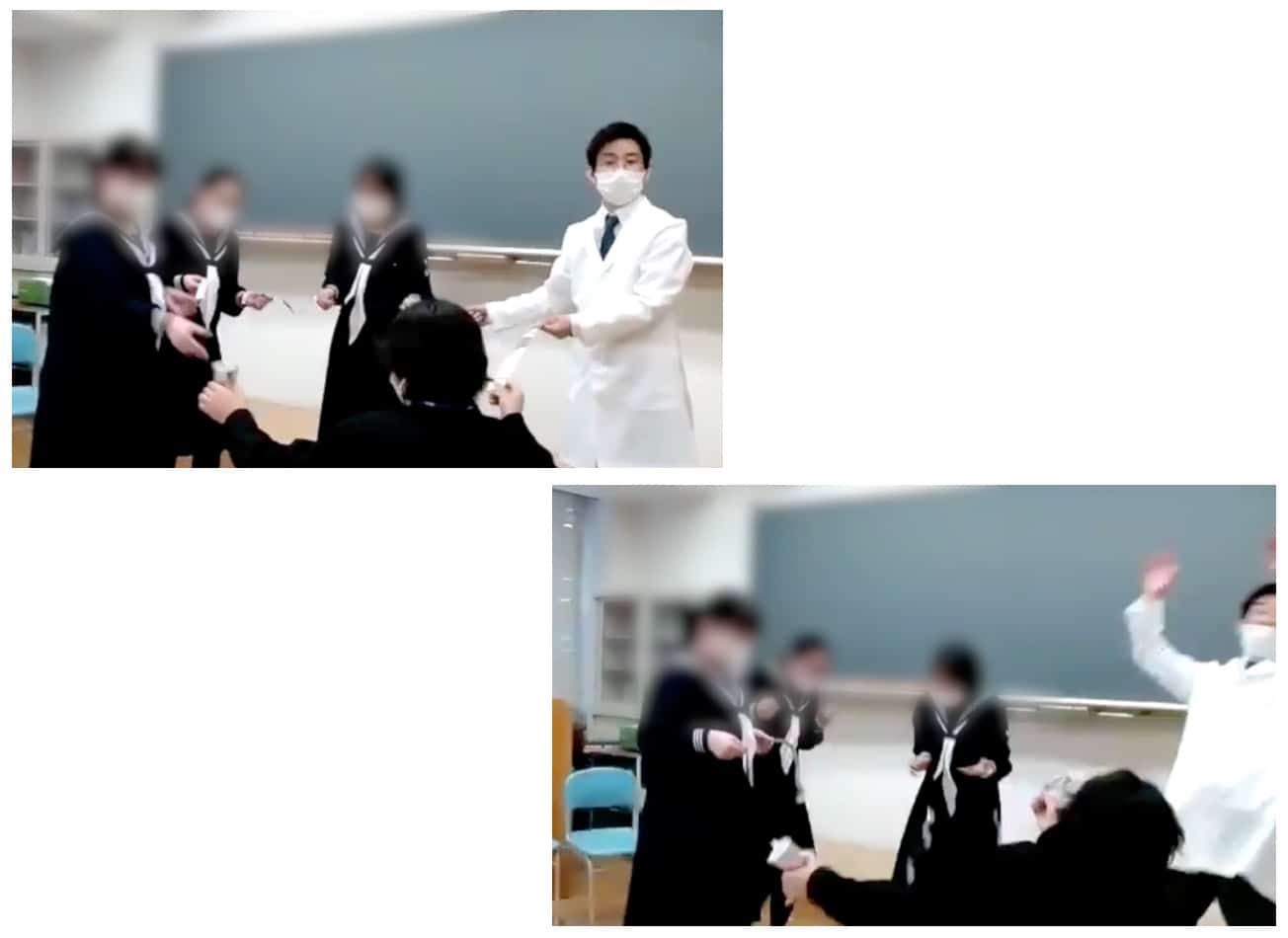
* Experiments using a static electricity generator must be conducted under the supervision of an expert. If trying this at home, please be extremely careful and prioritize safety.
For Those Who Want to Know More
If you are interested in learning more about the “Hyakunin Odoshi” and static electricity experiments introduced in this article, please check out the following links:
- Details of the experiment conducted on a TV show with Suzu Hirose
- 【Feature】You Can’t Stop! Static Electricity Experiments
- Considerations on Experiment Safety
- Historical Background of the “Hyakunin Odoshi”
※1 See TDK “The 76th: Electric and Magnetic Experiments of the Edo Period” https://www.jp.tdk.com/techmag/ninja/daa00682.htm
Contact and Requests
Bringing the wonder and fun of science closer to you! I’ve clearly summarized fun science experiments you can do at home and the tricks to make them work. Please search around!
・The content of the Science Idea Notebook is now a book. For more details, click here
・About the administrator, Kuwako Ken, click here
・For various requests (writing, lectures, experiment classes, TV supervision/appearances, etc.), click here
・Article updates are being distributed on X!
![]() Experiment videos are being distributed on the Science Idea Channel!
Experiment videos are being distributed on the Science Idea Channel!

